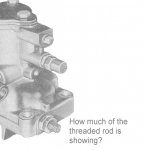I Really cant find any info to answer my question. I have 2 deuces, 1st is a 1969 model with C turbo,white engine, around 800 hours .The FDC Is still hooked up. My 2nd truck is a 1970 model, D turbo, herculies engine and around 300 hours. The FDC has been bypassed, it was that way when I bought it.
The 2nd truck (1970)feels like it has twice the power of the first truck. My 69 seems very doggy on hills and dosent accelerate very fast. I know these trucks are not hot rods but the 1970 model I have will pull hard going up hills( no downshifting) and flat out acccelerates almost as fast as you can shift. I am concerned that it may be set up two much. There is a small amount of black smoke under load on the faster truck. So-is my 1969 truck a dog or is my 1970 truck over fueled. They both start very well and run great. Any Ideas? Thankyou for your info.
PS these are the only deuces I have driven.
The 2nd truck (1970)feels like it has twice the power of the first truck. My 69 seems very doggy on hills and dosent accelerate very fast. I know these trucks are not hot rods but the 1970 model I have will pull hard going up hills( no downshifting) and flat out acccelerates almost as fast as you can shift. I am concerned that it may be set up two much. There is a small amount of black smoke under load on the faster truck. So-is my 1969 truck a dog or is my 1970 truck over fueled. They both start very well and run great. Any Ideas? Thankyou for your info.
PS these are the only deuces I have driven.
Last edited:




